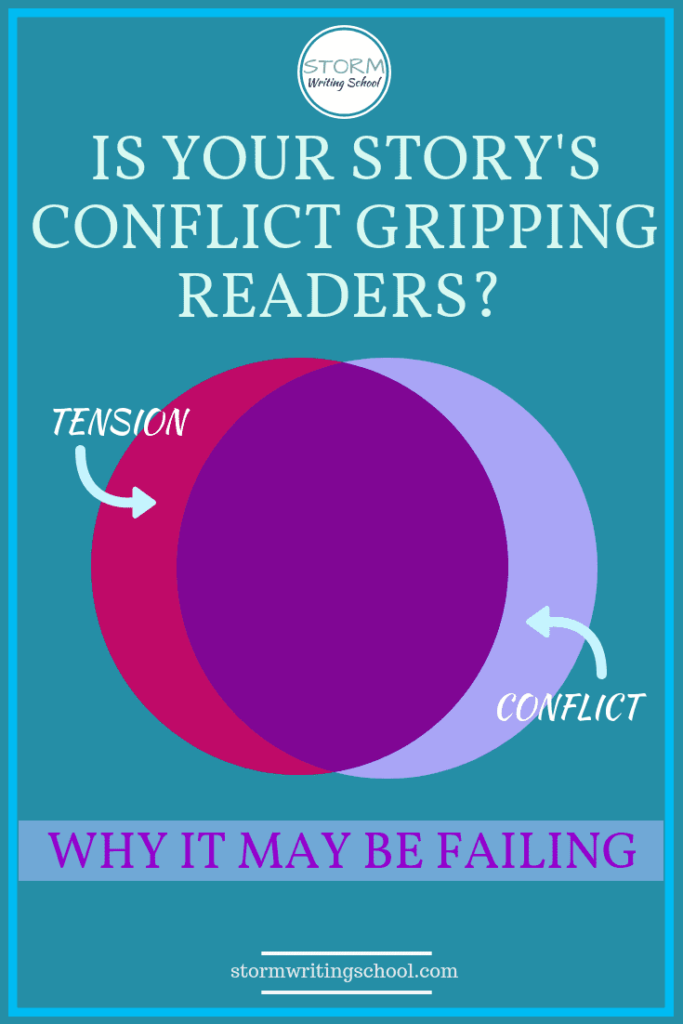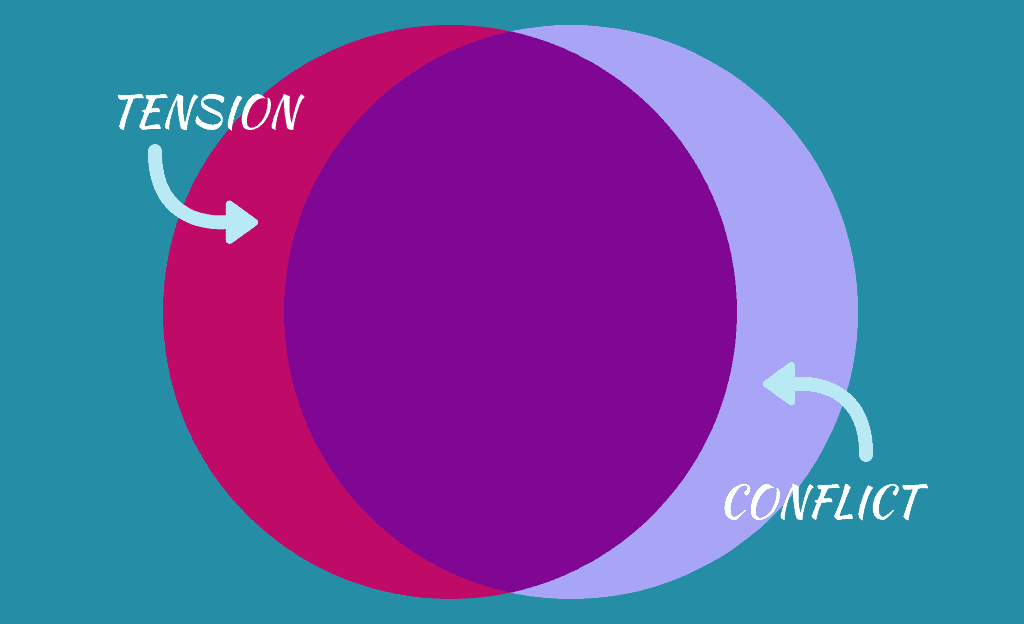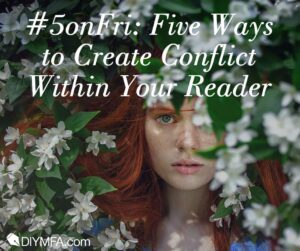We assume conflict and tension go hand in hand all the time, but they don’t. You can have tension without conflict and you can have conflict without tension.

Conflict Is Essential
What is conflict? James Scott Bell defines it as a clash between at least two incompatible sides. And he says that one of those sides must exercise conscious will. That is, a rock tumbling down a hillside onto a road isn’t conflict. But a rock tumbling into the path of a car traveling on said road is.
Your story needs conflict. It’s one of the most widely-accepted tenets of storytelling. As Charles Baxter says, “Only hell is interesting.” I mean, which story would you rather hear: the one about the tasty blueberry pancakes I ate at a seaside diner while watching surfers take on mildly-challening but very safe waves? Or the one about the menacing carny at the boardwalk amusement park who kept calling me Gussy and insisted I owed him twenty dollars for “that thing on Saturday”?
We want to live pleasant times, but we don’t want to hear stories about them. Without conflict, there’s no drama.
Tension as Top Priority
But it’s tension, not conflict, that really drives stories. We want to throw readers off balance a bit and get them craving some restoration of balance, some solution to problems that arise in our stories. Tension lies in that state of imbalance and uncertainty before answers and solutions arrive. And conflict is certainly the most straightforward way to create problems and imbalance.
But is conflict the only way to create tension? And will conflict ever fail to create tension?
Conflict vs. Tension
I want to offer some responses to those two questions above. In my editing in the past year, I’ve found myself asking those questions repeatedly. And I’ve arrived at some answers: no and yes.
1) Conflict isn’t the only way to create tension.
2) Some conflict creates very little tension.
Conflict Isn’t the Only Way
When I was in my mid-20s, I traveled around Europe for a summer and found myself in northern Spain during one of those crazy week-long festivals that Spaniards seem to relish more than most places in the world. I stowed my backpack in a hostel and roamed the town on my own.
Not too far into my night, I ended up in a crowded courtyard drinking kalimotxo with a couple guys I’d just met when I spotted a tall, freckle-faced woman across the courtyard. She laughed at something her friend said, and turned her head to the side, her black hair flipping over her shoulder, contrasting the glint of silver earrings dangling to her neck.
And then she caught me looking and stared right back at me, a mischeivous grin settling on her lips. We held eye contact for a good five seconds, probably the first time in my life I knew without a doubt that I was in the throes of mutual attraction.
Pause the story there. Are you feeling tension? I’m guessing you are.
But is that tension arising from conflict? I don’t think so.
Let’s say you have a story in which your protagonist is on the run, injured, hungry, and sleep-deprived. They come to a convent which they’ve been told welcomes all, and a kindly old woman answers the door. There’s no sense of trouble, no hint that this woman isn’t what she seems. And yet, there’s still tension in this scenario.
That’s because tension can arise from anticipation. When we see the protagonist encounter a situation that may be consequential (not necessarily conflict-ridden), we wonder what will come of it. Will that handsome American fellow walk across the courtyard and meet the Spanish beauty? Will the injured hero regain their strength at the convent?
(For more on this concept, see my blog post on The Key to Reader Engagement by the way.)
Tension-less Conflict
Not all conflict is created equal. Some will grip readers and some won’t.
Let’s revisit the carny.
He’s getting insistent. “Stop screwing around, Gussy,” he says to me.
“Dude. I’m not Gussy,” I tell him.
“Don’t ‘dude’ me, Bro. I know you have money on you. I saw you getting your money out to pay for your girl there.” I see him grab a tire iron from the trailer that makes up the base of the ride he’s manning, something ambigously called “The Sizzler.” He holds the tire iron iron behind his leg. He thinks he’s being sneaky.
I feel a tap on my shoulder and turn to see a woman with auburn-dyed hair and a tight tank top. “You really do look like Gussy,” she says to me in a low, raspy voice. “He’s by the ferris wheel. You should go check him out.” And then she yells, “He’s not Gussy, Carl! Give it a rest for God’s sake.”
I’m curious, of course, so I head toward the ferris wheel.
And pause here. At this point, I could come up against several problems.
- It’s crowded and I have trouble making my way through the crowds.
- My shoelaces are untied and I nearly trip.
- I end up at a pendulum ride called “Stomach Twister,” which I’ve mistaked for the ferris wheel; when I recognize my mistake and say, “Oh, this isn’t the ferris wheel,” some guy tells me I’m an idiot.
- The carny who called me Gussy is following me and he looks pissed off.
The above possibilities are not all created equal, are they? You get more tension when there’s more potential consequence to the conflict. And if the conflict is tightly woven to the context that precedes it—that is, if it’s an obvious continuation of previous events, goals, and conflicts—then it carries a bit more weight.
A Checklist
I’ll keep this simple. We’re looking for dramatic tension first and foremost. Tension usually comes from conflict, but not always. If you have conflicts on the page, you want consequence, integration with the main through-line of the story, and some external dimension.
- Do you have dramatic tension on the page? It can come from conflict, of course, but it can also come from anticipation of a positive outcome. This is your top priority.
- Is your conflict consequential? That is, will it potentially have a lasting impact on the characters? (You want a yes here.)
- Is your conflict too incidental? Does it have little to do with a desire or quest? (You want a no here.)
- Is the conflict too internal? Don’t get me wrong; internal conflict is important. But internal conflict works best when it is about dilemmas (i.e. tough decisions) faced by the characters. Grief and despondency can be a challenge to fill with tension.
Want to know more about tension? Sign up for my newsletter to get the free tension ebook, which contains 4 lessons on tension. Or take one of my courses:








15 Responses
This is a great article. I haven’t seen conflict and tension framed this way. Thanks for sharing
Thanks!
I’m totally calling you Gussy from now on. This post is great from an educational standpoint, but it was also great for a laugh. Thanks for that. I’ve been struggling to better understand the difference between tension and conflict, and this helped. I feel like I’ve always been on the edge of understanding, but I wasn’t quite there yet.
Thanks! Are you a closet carny, Raimey? 🙂
Emotional engagement comes in all sizes. It didn’t occur to me it was also tension. 🙂
Anna from elements of emaginette
For anyone who hasn’t already subscribed to get the Tension and Conflict eBook. I highly recommend it.
Aw, thanks, Kristina! That means a lot coming from you.
I was guilty of incidental conflict for a long time in my writing – conflict without significance or which was mentioned then thrown away before anything developed from it. Your post contains an awesome breakdown of different ways to include conflict, and reminded me of my previous pitfalls. Thanks for sharing!
Thanks, Elle!
This is wonderful. ‘Tensionless conflict’ — that sounds like an oxymoron. But I’ve seen it in my own writing. When I fix it, it makes a huge difference.
One of Margie Lawson’s “rules” is that there must be tension on every page … but it’s not always clear what is tension and what isn’t. This is a great reminder. Thanks!
Great article. Inever considered thta tension and conflict might not work together and when this happens. The concept of consequentiality is great and illuminating.
Hemingway set up the tension very well, often in the first sentence…then proceeded to unravel the conflict, amazing to see.